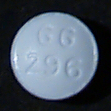 | |
 | |
| Clinical data | |
|---|---|
| Trade names | Claritin, Claratyne, Clarityn, others |
| AHFS/Drugs.com | Monograph |
| MedlinePlus | a697038 |
| License data |
|
| Pregnancy category |
|
| Routes of administration | By mouth |
| Drug class | Second-generation antihistamine |
| ATC code | |
| Legal status | |
| Legal status |
|
| Pharmacokinetic data | |
| Bioavailability | almost 100% |
| Protein binding | 97–99% |
| Metabolism | Liver (CYP2D6- and 3A4-mediated) |
| Elimination half-life | 8 hours, active metabolite desloratadine 27 hours |
| Excretion | 40% as conjugated metabolites into urine Similar amount into the feces |
| Identifiers | |
| |
| CAS Number | |
| PubChem CID | |
| IUPHAR/BPS | |
| DrugBank | |
| ChemSpider | |
| UNII | |
| KEGG | |
| ChEBI | |
| ChEMBL | |
| CompTox Dashboard (EPA) | |
| ECHA InfoCard | 100.120.122 |
| Chemical and physical data | |
| Formula | C22H23ClN2O2 |
| Molar mass | 382.89 g·mol−1 |
| 3D model (JSmol) | |
| |
| |
| | |
Loratadine, sold under the brand name Claritin among others, is a medication used to treat allergies. [4] This includes allergic rhinitis (hay fever) and hives. [4] It is also available in drug combinations such as loratadine/pseudoephedrine, in which it is combined with pseudoephedrine, a nasal decongestant. [4] It is taken orally. [4]
Contents
- Medical uses
- Combination drugs
- Dosage forms
- Contraindications
- Adverse effects
- Interactions
- Pharmacology
- Pharmacodynamics
- Pharmacokinetics
- History
- Society and culture
- Over the counter
- Brands
- Marketing
- References
Common side effects include sleepiness, dry mouth, and headache. [4] Serious side effects are rare and include allergic reactions, seizures, and liver problems. [5] Use during pregnancy appears to be safe but has not been well studied. [1] It is not recommended in children less than two years old. [5] It is in the second-generation antihistamine family of medications. [4]
Loratadine was patented in 1980 and came to market in 1988. [6] It is on the World Health Organization's List of Essential Medicines. [7] Loratadine is available as a generic medication. [4] [8] In the United States, it is available over the counter. [4] In 2023, it was the 105th most commonly prescribed medication in the United States, with more than 6 million prescriptions; [9] [10] and the combination with pseudoephedrine was the 300th most commonly prescribed medication in the United States, with more than 400,000 prescriptions. [11] [12]
